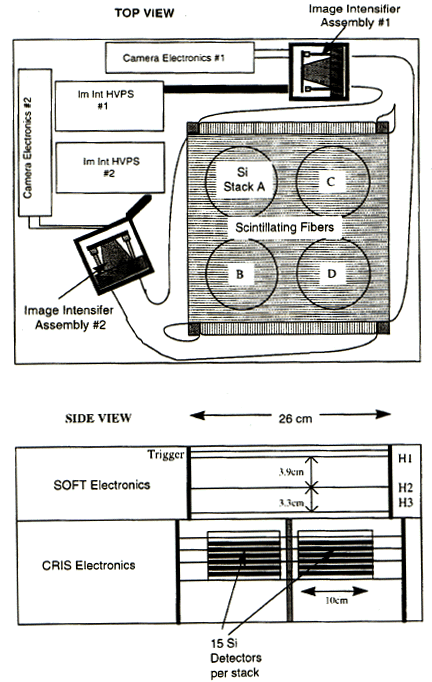![[Onion-Skin Model of Star]](images/onionskin.jpg)
![[CRIS photo]](images/CRIS.jpeg)
The Cosmic Ray Isotope Spectrometer (CRIS) on the Advanced Composition Explorer (ACE) spacecraft is intended to be a major step in ascertaining the isotopic composition of the cosmic rays and hence a major step in determining their origin. The GCRs consist, by number, primarily of hydrogen nuclei (~92%) and He nuclei (~7%). The heavier nuclei (1%) provide most of the information about cosmic-ray origin through their elemental and isotopic composition. The intensities of these heavy cosmic rays are very low and progress in the past has been impeded by limited particle collection power, particularly regarding individual isotopes. CRIS is designed to have far greater collection power (~250 cm²-sr) than previous satellite instruments (< 10 cm²-sr) while still maintaining excellent isotopic resolution up through Z=30 (Zinc) and beyond.
The elemental and isotopic composition of the Sun, which will be studied by SIS and other instruments on ACE, will provide one of the essential yardsticks by which to interpret the cosmic ray composition.
![[Onion-Skin Model of Star]](images/onionskin.jpg)
Many of the isotopes that will be collected by CRIS provide other information about the mechanisms of cosmic ray propagation (the study of the processes cosmic rays undergo between the time they are produced and the time of their arrival in the heliosphere). Radioactive "clock" nuclei provide information about the time between the production of cosmic rays and their acceleration to high energies. "Propagation clock" nuclei such as 10Be, 14C, 26Al, 36Cl, and 54Mn can tell us about the amount of time cosmic rays spend between acceleration and arrival in the heliosphere; that is, how long they spent wandering through the Galaxy before arriving here. K-capture secondary nuclei provide information about average densities of interstellar material encountered during propagation.
One of the most significant processes cosmic ray nuclei undergo during the time they spend in the Galaxy is spallation. This is when a nucleus interacts with another nucleus (say, a proton) and "breaks apart". Some GCR nuclei we observe are almost entirely produced in this way; these are called "secondary" nuclei. "Primary" nuclei, those for which most of the nuclei seen are survivors from the original time of their production, mixed-population nuclei (those which, upon arrival in the heliosphere, contain a substantial fraction of source nuclei) and secondary nuclei provide checks on propagation and specific source models, as well as providing information to those workers in the field of galactic chemical evolution.
![[Neutron # vs Z]](images/nucplot_new2.gif)
![[CRIS
Element/Isotopic Identification Regions]](images/crisplotnew.gif) If CRIS is to achieve the objectives of isotopic particle
identification beyond previous experiments, it must satisfy several
design requirements. It must achieve mass resolution of ~0.25 amu or
better for elements from Be to Ni (Z=4 to Z=28). For an instrument
that uses the multiple dE/dx-total energy
approach the mass resolution
is a sum of several contributions: those factors based on the physics of
interactions between charged particles and matter, and those based on
instrument design (e.g., electronics noise, trajectory determination).
The CRIS design was also driven by the requirement for statistically
accurate measurements of rare isotopes, especially in the Fe-Ni charge
region (see figure in previous section). As implemented in the actual
instrument, this has resulted in a geometry factor of up to 250
cm²-sr, many times larger than previous instruments of its kind.
The energy and Z intervals for which charge, mass, and incident energy
can be identified
are indicated in the gray area of the figure. Elemental
discrimination only and incident energy estimates can be achieved at higher
particle energies, while integral fluxes of particles can be
calculated based on events which completely penetrate a telescope.
If CRIS is to achieve the objectives of isotopic particle
identification beyond previous experiments, it must satisfy several
design requirements. It must achieve mass resolution of ~0.25 amu or
better for elements from Be to Ni (Z=4 to Z=28). For an instrument
that uses the multiple dE/dx-total energy
approach the mass resolution
is a sum of several contributions: those factors based on the physics of
interactions between charged particles and matter, and those based on
instrument design (e.g., electronics noise, trajectory determination).
The CRIS design was also driven by the requirement for statistically
accurate measurements of rare isotopes, especially in the Fe-Ni charge
region (see figure in previous section). As implemented in the actual
instrument, this has resulted in a geometry factor of up to 250
cm²-sr, many times larger than previous instruments of its kind.
The energy and Z intervals for which charge, mass, and incident energy
can be identified
are indicated in the gray area of the figure. Elemental
discrimination only and incident energy estimates can be achieved at higher
particle energies, while integral fluxes of particles can be
calculated based on events which completely penetrate a telescope.
 In CRIS, energy information about the cosmic ray particles is collected by
the 4 stacks of thick silicon detectors (shown as A-D), while the trajectory of the
particles are determined by the
Scintillating
Optical Fiber Trajectory (SOFT) system.
The 3 x- and y-layers of SOFT fibers are present for trajectory
redundancy and are viewed by two camera assemblies; which camera is
actually used at any given time is ground-commandable.
In CRIS, energy information about the cosmic ray particles is collected by
the 4 stacks of thick silicon detectors (shown as A-D), while the trajectory of the
particles are determined by the
Scintillating
Optical Fiber Trajectory (SOFT) system.
The 3 x- and y-layers of SOFT fibers are present for trajectory
redundancy and are viewed by two camera assemblies; which camera is
actually used at any given time is ground-commandable.
More information about the CRIS hardware is available.